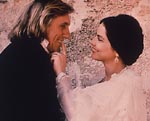
The very idea of Gérard Depardieu as The Count of Monte Cristo is irresistible. So what if the whole eight-hour mini-series (Monday, June 21, through Thursday, June 24; 8 to 10 p.m.; Bravo) is in venomous French, like the novel on which it improves? For the language-challenged and hearing-impaired, there are subtitles. These subtitles are in fact so easy to read, so pointed, pithy, and hardboiled-minimalist, that they shame most screenplays. But you will have to watch the screen instead of drifting off into your own nineteenth-century fantasies of revenge. And there on that screen, besides 3,500 extras and $20 million worth of Marseilles, Malta, and Naples, is a loping, long-jawed factory of vengefulness – the former Cyrano, the ex-Hamlet, last year’s Man in the Iron Mask, cross-dressing as an abbot, a blueblood, or a banker, hatching plots, wrecking lives, and savoring almost every excessive minute of it.
It seems to have been Depardieu’s project from the beginning, with the Goncourt Prize-winning academic Didier Decoin hired to spice up the novel with a lot more eating, drinking, and carnality than Dumas permitted his Edmond Dantès, and director Josée Dayan brought on board to emphasize the sensuous side of an operatic century. Thus, upon his escape after eighteen years in the island prison to which he was unfairly sentenced as a result of a conspiracy by his business and romantic rivals, the “Count” will take on tout Paris less like an ex-sailor than like a Russian czar, a monster of charming appetites. Thus Ornella Muti’s guilt-stricken Mercedes has, in Florence Darel’s self-abnegating Camille, some heavy competition for those banked affections. And thus, between the swashbuckling duels and the obligatory poisonings and the hilarious tantrums of the delegates to the National Assembly, there are some very modern riffs on counterfeit identities. The Count, in other words, is problematized.
But not enough to mess with our pleasure. We are reminded all over again of how satisfying the novel was as a dream of payback. We are reminded also of how much more fun it was to read about the nineteenth century than it is to read about the twentieth. And if the young Edmond arrested on his wedding day in 1815 looks surprisingly like the older Dantès befriended in prison by Abbé Faria, this is because he’s played by Guillaume Depardieu, Gérard’s own son – just as the young Mercedes, who will then marry the wrong man, so much resembles the older woman she grows up to be because she is played by Ornella Muti’s own daughter, Naike Rivelli. As the villains who get what they deserve, Jean Rochefort (Morcerf), Pierre Arditi (Villefort), and Michel Aumont (Baron Danglars) are nicely smarmy. I would have imagined Depardieu to be too big for his part, certainly harder to fit into the burial shroud from which, underwater, he has to Houdini himself (and then swim all the way to Italy), than Robert Donat (1934), Jean Marais (1954), Louis Jourdan (1961), or Richard Chamberlain (1975). But he just barrels his way to his mean objectives and his modern questions of authenticity. The surprise, really, is that he is not a killer – except of reputations, bank accounts, and peace of mind.
Enjoy yourself. And if you find that English subtitles aren’t a trial, maybe we can talk cable television into a whole festival of foreign films, undubbed and undumbed.